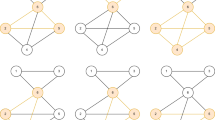Abstract
Most of works on the time complexity analysis of evolutionary algorithms have always focused on some artificial binary problems The time complexity of the algorithms for combinatorial optimisation has not been well understood. This paper considers the time complexity of an evolutionary algorithm for a classical combinatorial optimisation problem, to find the maximum cardinality matching in a graph. It is shown that the evolutionary algorithm can produce, a matching with nearly maximum cardinality in average polynomial time.
Similar content being viewed by others
References
Yao X (ed.). Evolutionary Computation: Theory and Applications. World Scientific Publishing, Singapore, 1999.
Liang K-Het al. A new evolutionary approach to cutting stock problems with and without contiguity.Computers and Operations Research, 2002, 29(12): 1641–1659.
Zhang C, Yao X, Yang J. An evolutionary approach to materialized views selection in a data warehouse environment.IEEE Trans. Systems, Man, and Cybernetics, Part C, 2001, 31(3): 282–294.
Rudolph G. Finite Markov chain results in evolutionary computation: A tour d'Horizon.Fundamenta Informaticae, 1998, 35(1–4): 67–89.
Eiben A E, Rudolph G. Theory of evolutionary algorithms: A bird's eye view.Theoretical Computer Science, 1999, 229(1–2): 3–9.
Beyer H-G, Schwefel H-P, Wegener I. How to analyse evolutionary algorithms.Theoretical Computer Science, 2002, 287(1): 101–130.
Droste S, Jansen T, Wegener I. A rigorous complexity analysis of the (1+1) evolutionary algorithm for linear functions with Boolean inputs.Evolutionary Computation, 1998, 6(2): 185–196.
Garnier J, Kallel L. Statistical distribution of the convergence time of evolutionary algorithms for long path problems.IEEE Trans. Evolutionary Computation, 2000, 4(1): 16–30.
Droste S, Jansen T, Wegener I. On the analysis of the (1+1) evolutionary algorithmsTheoretical Computer Science, 2002, 276(1–2): 51–81.
He J, Yao X. From an individual to a population: An analysis of the first hitting time of population-based evolutionary algorithms.IEEE Trans. Evolutionary Computation, 2002, 6(5): 495–511.
Papadimitriou C H, Steiglitz K. Combinatorial Optimization: Algorithms and Complexity. Dover, Mineola, NY, 1998.
Karpinski M, Rytter W. Fast Parallel Algorithms for Graph Matching Problems. Oxford University Press, Oxford, 1998.
Sasaki G H, Hajek B. The time complexity of maximum matching by simulated annealing.J. ACM, 1988, 35(2): 387–403.
Yao X. Maximum matching on Boltzmann machines.Neural Processing Letters, 1998, 7(1): 49–53.
He J, Yao X. Drift analysis and average time complexity of evolutionary algorithms.Artificial Intelligence, 2001, 127(1): 57–85.
He J, Yao X. Erratum to: Drift analysis and average time complexity of evolutionary algorithms — [Artificial Intelligence, 2001, 127: 57–85].Artificial Intelligence, 2002, 140(1): 245–248.
He J, Yao X. Towards an analytic framework for analysing the computationtime of evolutionary algorithms.Artificial Intelligence, 2003, 145(1–2): 59–97.
Hajek B. Hitting time and occupation time bounds implied by drift analysis with applications.Advances in Applied Probability, 1982, 14(3): 502–525.
Meyn S P, Tweedie R L. Markov Chains and Stochastic Stability. Springer-Verlag, New York, 1993.
Author information
Authors and Affiliations
Corresponding author
Additional information
The work is partially supported by Engineering and Physical Sciences Research Council (GR/R52541/01) and State Key Lab of Software Engineering at Wuhan University. The work was reported at UK 2002 Workshop on Computational Intelligence.
Jun He received his M.Sc. degree in mathematics and Ph.D. degree in computer science from Wuhan University, China, in 1992 and 1995 respectively. He is currently a research fellow at University of Birmingham, England. His research interests include evolutionary computation, network security and parallel algorithms.
Xin Yao received the Ph.D. degree in computer science from the Univ. Sci. Tech. China in 1990. He is currently a professor of computer science at the University of Birmingham, England. He is a fellow of IEEE. His major research interests include evolutionary computation, neural network ensembles, co-evolution, evolvable hardware, time complexity of evolutionary algorithms, and data mining. He published extensively in these areas.
Rights and permissions
About this article
Cite this article
He, J., Yao, X. Time complexity analysis of an evolutionary algorithm for finding nearly maximum cardinality matching. J. Compt. Sci. & Technol. 19, 450–458 (2004). https://doi.org/10.1007/BF02944746
Received:
Revised:
Issue Date:
DOI: https://doi.org/10.1007/BF02944746




